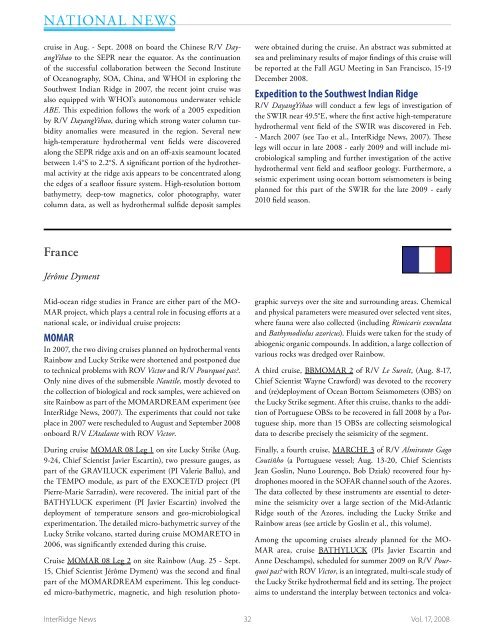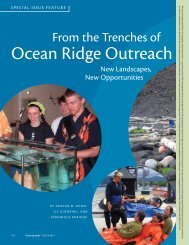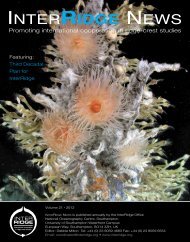Full version, lower resolution, 3.25MB - InterRidge
Full version, lower resolution, 3.25MB - InterRidge
Full version, lower resolution, 3.25MB - InterRidge
You also want an ePaper? Increase the reach of your titles
YUMPU automatically turns print PDFs into web optimized ePapers that Google loves.
National News<br />
cruise in Aug. - Sept. 2008 on board the Chinese R/V DayangYihao<br />
to the SEPR near the equator. As the continuation<br />
of the successful collaboration between the Second Institute<br />
of Oceanography, SOA, China, and WHOI in exploring the<br />
Southwest Indian Ridge in 2007, the recent joint cruise was<br />
also equipped with WHOI’s autonomous underwater vehicle<br />
ABE. This expedition follows the work of a 2005 expedition<br />
by R/V DayangYihao, during which strong water column turbidity<br />
anomalies were measured in the region. Several new<br />
high-temperature hydrothermal vent fields were discovered<br />
along the SEPR ridge axis and on an off-axis seamount located<br />
between 1.4°S to 2.2°S. A significant portion of the hydrothermal<br />
activity at the ridge axis appears to be concentrated along<br />
the edges of a seafloor fissure system. High-<strong>resolution</strong> bottom<br />
bathymetry, deep-tow magnetics, color photography, water<br />
column data, as well as hydrothermal sulfide deposit samples<br />
Among the upcoming cruises already planned for the MO-<br />
MAR area, cruise BATHYLUCK (PIs Javier Escartin and<br />
Anne Deschamps), scheduled for summer 2009 on R/V Pourquoi<br />
pas? with ROV Victor, is an integrated, multi-scale study of<br />
the Lucky Strike hydrothermal field and its setting. The project<br />
aims to understand the interplay between tectonics and volcawere<br />
obtained during the cruise. An abstract was submitted at<br />
sea and preliminary results of major findings of this cruise will<br />
be reported at the Fall AGU Meeting in San Francisco, 15-19<br />
December 2008.<br />
Expedition to the Southwest Indian Ridge<br />
R/V DayangYihao will conduct a few legs of investigation of<br />
the SWIR near 49.5°E, where the first active high-temperature<br />
hydrothermal vent field of the SWIR was discovered in Feb.<br />
- March 2007 (see Tao et al., <strong>InterRidge</strong> News, 2007). These<br />
legs will occur in late 2008 - early 2009 and will include microbiological<br />
sampling and further investigation of the active<br />
hydrothermal vent field and seafloor geology. Furthermore, a<br />
seismic experiment using ocean bottom seismometers is being<br />
planned for this part of the SWIR for the late 2009 - early<br />
2010 field season.<br />
France<br />
Jérôme Dyment<br />
Mid-ocean ridge studies in France are either part of the MO-<br />
MAR project, which plays a central role in focusing efforts at a<br />
national scale, or individual cruise projects:<br />
MOMAR<br />
In 2007, the two diving cruises planned on hydrothermal vents<br />
Rainbow and Lucky Strike were shortened and postponed due<br />
to technical problems with ROV Victor and R/V Pourquoi pas?.<br />
Only nine dives of the submersible Nautile, mostly devoted to<br />
the collection of biological and rock samples, were achieved on<br />
site Rainbow as part of the MOMARDREAM experiment (see<br />
<strong>InterRidge</strong> News, 2007). The experiments that could not take<br />
place in 2007 were rescheduled to August and September 2008<br />
onboard R/V L’Atalante with ROV Victor.<br />
During cruise MOMAR 08 Leg 1 on site Lucky Strike (Aug.<br />
9-24, Chief Scientist Javier Escartin), two pressure gauges, as<br />
part of the GRAVILUCK experiment (PI Valerie Ballu), and<br />
the TEMPO module, as part of the EXOCET/D project (PI<br />
Pierre-Marie Sarradin), were recovered. The initial part of the<br />
BATHYLUCK experiment (PI Javier Escartin) involved the<br />
deployment of temperature sensors and geo-microbiological<br />
experimentation. The detailed micro-bathymetric survey of the<br />
Lucky Strike volcano, started during cruise MOMARETO in<br />
2006, was significantly extended during this cruise.<br />
Cruise MOMAR 08 Leg 2 on site Rainbow (Aug. 25 - Sept.<br />
15, Chief Scientist Jérôme Dyment) was the second and final<br />
part of the MOMARDREAM experiment. This leg conducted<br />
micro-bathymetric, magnetic, and high <strong>resolution</strong> photographic<br />
surveys over the site and surrounding areas. Chemical<br />
and physical parameters were measured over selected vent sites,<br />
where fauna were also collected (including Rimicaris exoculata<br />
and Bathymodiolus azoricus). Fluids were taken for the study of<br />
abiogenic organic compounds. In addition, a large collection of<br />
various rocks was dredged over Rainbow.<br />
A third cruise, BBMOMAR 2 of R/V Le Suroît, (Aug. 8-17,<br />
Chief Scientist Wayne Crawford) was devoted to the recovery<br />
and (re)deployment of Ocean Bottom Seismometers (OBS) on<br />
the Lucky Strike segment. After this cruise, thanks to the addition<br />
of Portuguese OBSs to be recovered in fall 2008 by a Portuguese<br />
ship, more than 15 OBSs are collecting seismological<br />
data to describe precisely the seismicity of the segment.<br />
Finally, a fourth cruise, MARCHE 3 of R/V Almirante Gago<br />
Coutiñho (a Portuguese vessel; Aug. 13-20, Chief Scientists<br />
Jean Goslin, Nuno Lourenço, Bob Dziak) recovered four hydrophones<br />
moored in the SOFAR channel south of the Azores.<br />
The data collected by these instruments are essential to determine<br />
the seismicity over a large section of the Mid-Atlantic<br />
Ridge south of the Azores, including the Lucky Strike and<br />
Rainbow areas (see article by Goslin et al., this volume).<br />
<strong>InterRidge</strong> News 32 Vol. 17, 2008
















